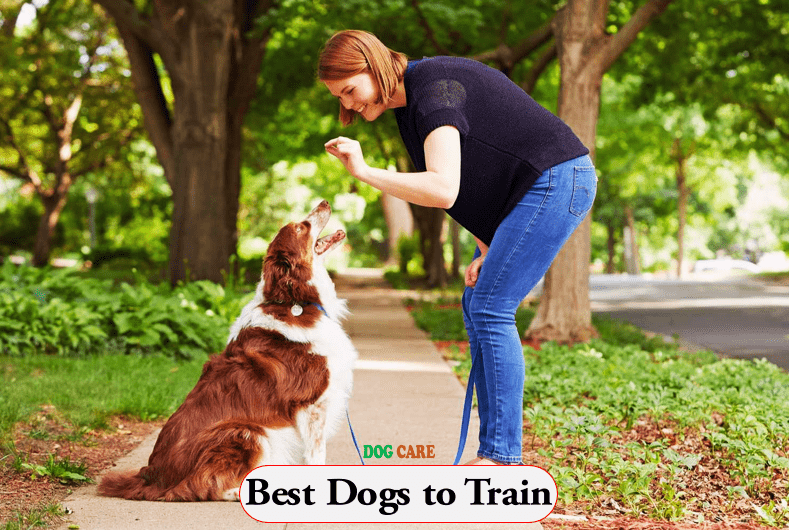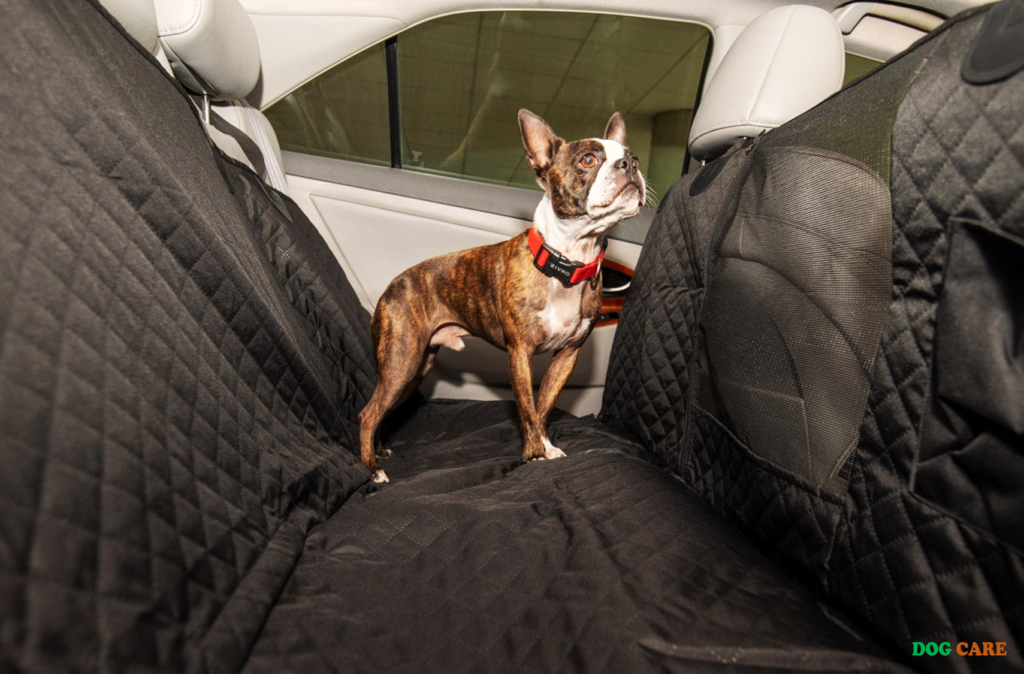Best Dogs to Train – Labradors and Border Collies are the best dogs to train due to their high intelligence and eagerness to please their owners. These breeds excel in obedience training and can easily learn a variety of commands and tricks.
They are quick learners and have a strong desire for mental stimulation, making them highly trainable and responsive to positive reinforcement. Labradors are known for their calm and sociable nature, while Border Collies are renowned for their agility and focus.
Both breeds are loyal, adaptable, and thrive in environments where they are given plenty of mental and physical exercise.

Choosing The Right Dog Breed
When it comes to dog training, it’s crucial to choose the right breed that best suits your needs and lifestyle. Different dog breeds have different temperaments, energy levels, and trainability, which can significantly impact the training process and overall success. Therefore, taking into consideration several factors can help you make an informed decision when choosing a dog breed to train.
Considerations For Training
- Temperament: Ensure the breed’s temperament aligns with what you are looking for in a dog. Some breeds are more independent, while others are more sociable and eager to please.
- Size: Consider the size of the dog breed you prefer. Smaller breeds might be easier to manage during training sessions, especially for beginners.
- Activity Level: Different breeds have varying energy levels. It’s important to choose a breed that matches your activity level and lifestyle to ensure you can provide sufficient exercise and mental stimulation.
- Trainability: While all dogs can be trained, certain breeds are known for their trainability. These breeds tend to grasp commands quickly and are more willing to follow instructions.
- Family Compatibility: If you have a family or are planning to start one, consider a breed that is known to be good with children and other pets.
Popular Dog Breeds For Training
When it comes to training, some dog breeds stand out for their exceptional intelligence, quick learning abilities, and willingness to please their owners. Here are a few popular dog breeds known for being highly trainable:
| Breed | Trainability | Temperament | Size |
|---|---|---|---|
| Labrador Retriever | High | Friendly, Outgoing | Large |
| German Shepherd | High | Loyal, Intelligent | Large |
| Poodle | High | Intelligent, Alert | Varies (Standard, Miniature, Toy) |
| Border Collie | High | Energetic, Agile | Medium |
These popular breeds are known for their trainability and versatility in various training activities such as obedience, agility, and even specialized tasks like search and rescue or therapy work.
Remember, successful dog training is a result of consistent effort, patience, and the right breed choice. By considering the temperaments, trainability, and other factors, you can find a dog breed that will not only be a loving companion but also a joy to train and shape into a well-behaved member of your family.
Training Techniques And Tips
When it comes to training your dog, it’s important to use effective techniques and establish a strong bond with your furry friend. By using the right training methods, you can help your dog become well-behaved and obedient. In this article, we will explore some popular training techniques and provide you with valuable tips to ensure success in your dog’s training journey.
Positive Reinforcement
Dogs respond well to positive reinforcement. This means rewarding your dog for good behavior rather than punishing them for bad behavior. It’s essential to praise and reward your dog when they follow your commands correctly. This not only motivates them but also strengthens the bond between you and your pet.
Here are some effective ways to implement positive reinforcement in your dog’s training:
- Use treats as rewards when your dog performs a desired behavior.
- Offer enthusiastic praise, such as saying “good boy” or “good girl.”
- Use a clicker to mark the desired behavior and then reward your dog.
Clicker Training
Clicker training is a popular and effective technique that uses sound to mark the desired behavior in a dog. This method helps dogs understand that they have done something right and a reward is coming. Here are the steps to follow for clicker training:
- Get a clicker device, which makes a distinct sound.
- Associate the sound of the clicker with a treat by clicking it and immediately giving your dog a treat.
- Use the clicker to mark the desired behavior, and then reward your dog with a treat.
- Repeat this process consistently to reinforce positive behaviors.
Socialization
Socializing your dog is crucial for their development and overall behavior. Early socialization helps them become comfortable and confident in various situations and around different people and animals. Here’s how you can ensure proper socialization of your dog:
- Expose your dog to different environments, such as parks, busy streets, and other public places.
- Introduce your dog to other dogs, animals, and people in a controlled and positive manner.
- Enroll your dog in obedience classes or training sessions where they can interact with other dogs.
Consistency And Routine
Dogs thrive on consistency and routine. Establishing a consistent training routine will help them understand the expectations and reinforce their training. Consider the following tips:
- Set a specific time for training sessions each day.
- Use consistent verbal commands for each behavior you want to teach.
- Ensure everyone in your household follows the same training methods and commands.
- Be patient and consistent with your dog’s training progress, as it takes time for them to learn and adapt.
Advanced Training For Dogs
Dogs are intelligent creatures capable of learning a wide range of behaviors and tricks. Once they have mastered the basics, they are ready to move on to advanced training. Advanced training for dogs encompasses a variety of skills that go beyond the essential obedience commands. From obedience training to trick training and agility training, these advanced skills not only strengthen the bond between dog and owner but also provide mental stimulation, physical exercise, and enhance the overall well-being of your furry friend.
Obedience Training
Obedience training is the foundation for advanced dog training and ensures that your dog follows basic commands consistently. This training not only keeps your dog safe but also makes them a well-behaved companion. Dogs that have undergone obedience training are more responsive, disciplined, and reliable in various situations.
During obedience training, dogs learn essential commands such as “sit,” “stay,” “heel,” “come,” and “down.” These commands enable you to have control over your dog’s behavior both on and off-leash. Obedience training provides the groundwork for more advanced skills and creates a strong foundation for further training and behavior modification.
Trick Training
Trick training involves teaching your dog a repertoire of fun and entertaining tricks. While tricks may seem like just playful behavior, they actually serve multiple purposes. They enhance your dog’s mental stimulation, build their confidence, and strengthen the bond between you and your furry companion.
Trick training includes teaching your dog tricks such as “shake hands,” “roll over,” “play dead,” “spin,” and many more. These tricks not only impress your friends and family but also provide your dog with an outlet for their energy and intelligence. By engaging in trick training, you are giving your dog a chance to showcase their unique abilities and tap into their natural problem-solving skills.
Agility Training
Agility training involves navigating your dog through an obstacle course, testing their speed, agility, and accuracy. This training is not only physically demanding but also mentally stimulating, making it an excellent choice for dogs that require additional challenges.
During agility training, dogs learn to maneuver through tunnels, weave poles, A-frames, and other obstacles while following your commands. Agility training helps improve your dog’s coordination, agility, and fitness levels. It also promotes their problem-solving abilities and enhances their confidence as they conquer different challenges. Whether you choose to compete in agility trials or simply engage in agility training for fun, this activity is sure to keep your dog physically and mentally engaged.
Developing A Strong Bond With Your Dog
Developing a strong bond with your dog is essential for effective training. Dogs are social animals and thrive on human companionship. When you establish a strong bond, your dog will be more willing to listen and learn from you. In this article, we will explore three key factors that can help you develop a strong bond with your furry friend: communication and body language, building trust, and quality time and play.
Communication And Body Language
Communication is the foundation of any successful relationship, and the same holds true for your bond with your dog. While dogs cannot understand human language, they are highly attuned to body language and non-verbal cues. By learning to communicate effectively, you can establish a clear line of understanding between you and your dog.
You can use various body language signals to convey your intentions to your dog. For example, maintaining eye contact and using a calm, assertive posture can signal authority and leadership. Additionally, using hand signals along with verbal cues can help reinforce your commands.
Remember, consistency is key when it comes to communication. Your dog will learn to associate specific signals with desired behaviors over time. By being consistent in your body language and cues, you can strengthen the bond and understanding between you and your dog.
Building Trust
A strong bond is built on a foundation of trust and mutual respect. To gain your dog’s trust, it is important to establish yourself as a reliable and consistent presence in their life.
Building trust starts with positive reinforcement. Rewarding your dog for good behavior and offering praise and affection will create a positive association with you. Avoid punishing or scolding your dog for mistakes, as it can erode trust and hinder their training progress.
Additionally, spending quality time with your dog is crucial for building trust. Take them on regular walks, engage in interactive play sessions, and provide mental stimulation through training exercises. This will not only strengthen the bond between you and your dog but also create a sense of security and trust in your relationship.
Quality Time And Play
Spending quality time and engaging in play activities is not only enjoyable for both you and your dog but also instrumental in fostering a strong bond.
Make sure to set aside dedicated time for play every day. This can include games like fetch or interactive toys that stimulate their mental and physical abilities. Engaging in play sessions not only provides exercise but also helps release any excess energy, reducing the likelihood of destructive behaviors.
Additionally, using play as a training tool can further strengthen the bond. Incorporate training exercises into play activities to make the experience fun and rewarding for your dog. This will enhance their engagement and motivation to learn.
Remember, the goal is to create positive experiences and enjoyable moments with your dog. By dedicating quality time for play and training, you can deepen your bond and create a harmonious relationship built on trust, communication, and mutual understanding.
Common Challenges In Dog Training
While dog training can be a rewarding experience, it also comes with its fair share of challenges. From house training accidents to leash pulling, barking, and jumping on people, these common challenges require patience, consistency, and effective training techniques to overcome. In this blog post, we will discuss each of these challenges in more detail and provide helpful tips on how to address them.
House Training
House training is one of the first and most important skills to teach your dog. It can be a frustrating challenge, especially during the initial stages. However, with the right approach, you can successfully train your dog to eliminate in appropriate areas.
A few tips for house training:
- Set up a consistent daily feeding schedule to create a routine for your dog’s bathroom breaks.
- Designate a specific area outside for your dog to do their business, and always bring them to that spot.
- Use positive reinforcement, such as treats and praise, when your dog eliminates in the appropriate area.
- Be patient and consistent with the training process, as accidents are bound to happen.
Leash Pulling
Leash pulling is a common challenge that many dog owners face, especially during walks. It can be frustrating and make walks less enjoyable. However, with the right training techniques, you can teach your dog to walk politely on a leash.
Here are some tips for leash pulling:
- Start with basic leash training exercises in a distraction-free environment.
- Use positive reinforcement techniques, rewarding your dog for walking by your side.
- Consider using a front-clip harness, which provides more control and discourages pulling.
- Be consistent with your training and gradually increase the level of distractions as your dog improves.
Barking
Barking is a natural behavior for dogs, but excessive barking can become a problem. It can disturb neighbors, cause tension, and even lead to legal issues in some cases. Fortunately, there are techniques to address and manage excessive barking.
Here are a few tips for dealing with barking:
- Identify the triggers that cause your dog to bark excessively and work on desensitizing them.
- Teach your dog the “quiet” command and reward them when they stop barking on command.
- Provide mental and physical stimulation to keep your dog engaged and less likely to bark out of boredom.
- Consult a professional dog trainer or behaviorist if the barking issue persists.
Jumping On People
Many dogs tend to jump on people as a way to greet them. While it may seem harmless, it can be problematic, especially when dealing with elderly or young individuals. Teaching your dog appropriate greetings is crucial to prevent this behavior.
Here are some tips for addressing jumping on people:
- Ignore the jumping behavior and only provide attention when your dog has all four paws on the ground.
- Teach your dog an alternative greeting behavior, such as sitting or offering a paw.
- Reward your dog for appropriate greetings and consistently reinforce these behaviors.
- Train your dog to stay calm and maintain self-control when encountering exciting situations.
Frequently Asked Questions Of Best Dogs To Train
What Are The Best Dog Breeds To Train?
Some of the best dog breeds to train include Border Collies, German Shepherds, and Golden Retrievers. These breeds are known for their high intelligence and eagerness to please, making them highly trainable and responsive to commands.
Why Are Border Collies Good To Train?
Border Collies are known for their exceptional intelligence and natural herding abilities. They are quick learners, highly trainable, and excel in obedience training. Their high energy levels and laser-like focus make them ideal candidates for advanced training in various disciplines such as agility and flyball.
What Makes German Shepherds Easy To Train?
German Shepherds are renowned for their intelligence, loyalty, and versatility. Their eagerness to learn, coupled with their desire to please their owners, makes them highly trainable dogs. They pick up commands quickly and excel in various training activities such as obedience, protection, and search and rescue.
Why Are Golden Retrievers Popular For Training?
Golden Retrievers are intelligent, friendly, and eager to please, which makes them excellent candidates for training. They respond well to positive reinforcement methods and excel in obedience training. Their gentle nature and ability to quickly learn commands make them sought after for therapy and assistance dog training.
Conclusion
To sum it up, training your dog is an essential aspect of pet ownership. From the loyal Labrador Retriever to the intelligent Border Collie, there are various breeds that excel in training. These dogs are not only eager to learn, but they also enjoy the mental and physical stimulation that training provides.
So, whether you’re a first-time dog owner or an experienced trainer, consider welcoming one of these trainable breeds into your home. It is truly a rewarding experience that will strengthen the bond between you and your furry friend.


